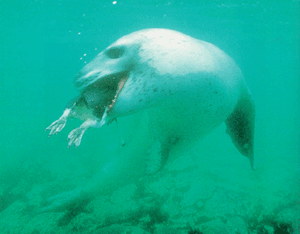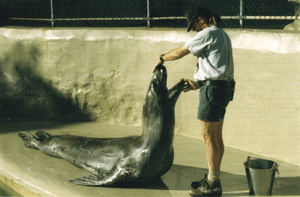An acoustic survey of the Antarctic leopard seal population.
Kate Anderson and Michelle Chambers
The Australian Marine Mammal Research Centre
Currently there are no accurate estimates of the leopard seal
population within the Antarctic pack ice. It is thought that the population
ranges from 220,000 to 440,000.  This
wide variation is due to the fact that these animals are extremely hard to count
from ship board surveys. Visual surveys are conducted during the summer months
and only count those animals which are hauled out on the ice. At this time of
year it has been found that leopard seals spend up to 18 hours a day underwater
vocalising. It is thought that these calls are used to attract mates during
the breeding season.
This
wide variation is due to the fact that these animals are extremely hard to count
from ship board surveys. Visual surveys are conducted during the summer months
and only count those animals which are hauled out on the ice. At this time of
year it has been found that leopard seals spend up to 18 hours a day underwater
vocalising. It is thought that these calls are used to attract mates during
the breeding season.
 We
are proposing that these sounds can be used as a way of assessing the leopard
seal population, in the form of an acoustic survey. Using underwater recordings
made remotely from the ship we hope to calculate density estimates by counting
the calls made by the seals. To convert abundance estimates to density we also
need to know the range over which we can detect calling seals. The use of a
hydrophone array set up on ice floes will allow this to be calculated via triangulation
methods. It is likely that the noise of the ship is masking some vocalisations,
hence investigations are being carried out to determine the effects of engine
noise on the audibility of vocalisations.
We
are proposing that these sounds can be used as a way of assessing the leopard
seal population, in the form of an acoustic survey. Using underwater recordings
made remotely from the ship we hope to calculate density estimates by counting
the calls made by the seals. To convert abundance estimates to density we also
need to know the range over which we can detect calling seals. The use of a
hydrophone array set up on ice floes will allow this to be calculated via triangulation
methods. It is likely that the noise of the ship is masking some vocalisations,
hence investigations are being carried out to determine the effects of engine
noise on the audibility of vocalisations.
Leopard seal vocalisations are species specific and highly stereotyped.
There is no variation from year to year or between individuals as has been found
in many whale acoustic studies. This makes the leopard seal a perfect candidate
for such an acoustic survey. The preliminary work already shows that visual
surveys are underestimating leopard seal distribution and abundance. Our work
also indicates that with further study Ross seal populations could also be surveyed
acoustically.
click on
"Tim the Penguin" to return to Antarctica 1999-2000 Page
